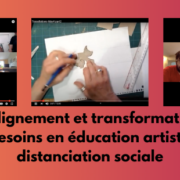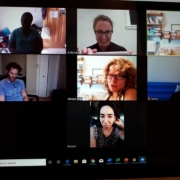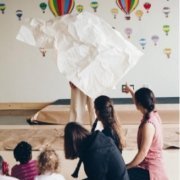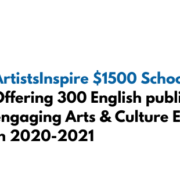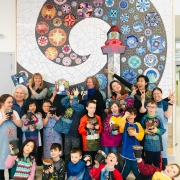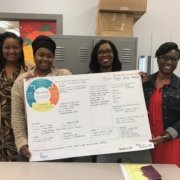ACE Lessons Learned: How ELAN Art Ed Artist-Residencies in Rural Communities Benefit Artists
ELAN Quebec’s ACE Initiative connects artists with schools all over Quebec. Sometimes, artists are paired with schools in regions that are located far away from their hometown. This provides intercultural exposure for both the artist and the community in which they are working. This intercultural exposure creates an excellent innate learning opportunity for the students and community, in addition to their benefiting from the expertise of the artist. This inherent benefit goes both ways- as well as to having an opportunity to develop facilitation skills, the artist can also be positively impacted by being in a different community.
ACE residencies are different than other artistic programs that are delivered in rural communities in that they follow a long-term model, instead of the more typical short-term residency. ACE artists typically work in the community for a month on a project. Afterwards, the partnership can grow: if the school administration is keen on having artists continue to come to their school, ACE will work to continue to send an artist into the community in subsequent years. Also, the artist might return to the region through the relationships they have formed with the school, and other community partners.
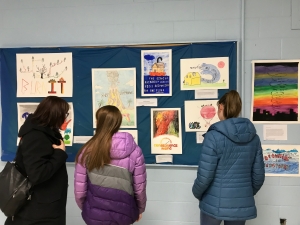
A vernissage of the artwork of students at New Richmond High School. Photo: Siu-Min Jim
This obviously benefits the school and community by continuing to expose their students to the arts, enabling these students to gain the health and academic benefits of having arts in their education. The practices taught by the artist can also be enacted during periods when there are no artists-in-residence. An example of a community that has had multiple ACE projects in its school is the remote community of Chevery-Harrington on the Lower North Shore. This community has had an artist come to their school every year through ACE for the past three years. ACE and Netagamiou School are trying to make this a five-year partnership.
This year, ¼ of our ACE artists were artists-in-residence in the communities in which they were based, while many more were based in rural areas close to the communities-of-residence of the ACE artists. Artist, playwright, actor and director Laura Teasdale was based in New Richmond, on the Gaspé Peninsula; graphic designer, graffiti artist, and muralist Jimmy Baptiste was working Richmond, in the Eastern Townships; and musician and composer Louise Campbell enacted her participatory arts practice in Grosse Île, in the Magdalene Islands.
As mentioned, ACE projects in rural communities don’t only benefit the schools, they also benefit the artists. Reflecting on her experience, Louise acknowledges that the remoteness of her ACE project benefitted her artistic and teaching practice, saying, “I enjoyed getting to know the people in Grosse-Ile for somewhat selfish reasons. I have always lived in medium to large-sized urban centres and being in Grosse-Ile for a month was a small taste of what it might be like to live in a small community. There are benefits and drawbacks to every place, and the trick is to take advantage of the best parts of every place you go or live. Animating an ACE project in Grosse-Ile was an opportunity for me to question my regular ways of doing things and find a way to make music with the people in Grosse-Ile that was the best way for them to make music”. While in Grosse-Ile, Louise also created a musical piece for use in an exhibit in a local museum, “People of the Sea”, which commemorates those lost at sea from the community.
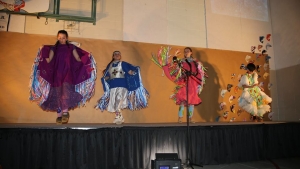
Part of the performance at Richmond High School. Photo: Darlene Dimock
In New Richmond, Laura Teasdale created an enduring partnership both with the New Richmond High School, and with other schools in the region. News of her impact spread, and communities up the coast have requested that she works in their schools next year. She wrote of her project that, “there is something magical about going to a remote area to do this kind of work. It feels like an epic adventure. You are so far away from your everyday life, it gives weight and importance to the work. You are there for no other reason, so you become completely absorbed in the project. And everyone in remote small towns knows each other, so it is easy to make connections quickly and to become invested in their lives. I felt surrounded by synchronicity. Like I was exactly where I needed to be and where they needed me to be”.
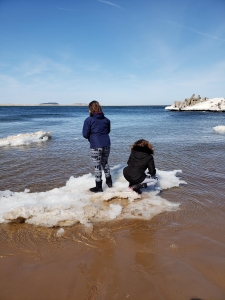
Gathering sound recordings for the radio drama, in Grosse Ile. Photo: Louise Campbell
Jimmy Baptiste reports that though it is always had for him to leave his community in Montreal to facilitate artistic projects in other regions, it always feels worth it because of the exposure to new thinking patterns challenges him to be more flexible with his facilitation practice. He writes that, “I love working with ACE outside of my community because I get to discover and see new places that I might not be able to see otherwise. Furthermore, working with students from different places create an interesting and beautiful dynamic since they get to discover new art techniques”. In all the 2018/2019 rural ACE projects, connections and new patterns of artistic and faciliatory practice were established, to deepen professional development.
ELAN has two artist-in-schools projects, the ACE Initiative and the Artists Inspire Grants (which are also supported by LEARN), under the umbrella of ELAN’s Arts Education Initiatives this year. Both projects can support artist-residencies in rural communities, and the impact and duration of a project through either initiative can be extended through drawing on other funding sources, such as the Culture in the Schools program. Applications for both programs will be open by June 2019. An ELAN Art Ed artist-residency can benefit both the artist and the school; get your application ready to see your artistic and faciliatory practices, or students, grow next year.

